
06 Jul Publisher’s Note: A Wild Legacy
Carl Clemens Moritz Rungius [1869 – 1959] is widely regarded as the premier painter of American wildlife. This painting and many of his best are now part of an impressive exhibition at the National Museum of Wildlife Art in Jackson, Wyoming.
Rungius’ first visit to Wyoming and Yellowstone in 1895 began a lifelong love affair with the American West and, subsequently, the Canadian Rockies, where he built a studio in Banff in 1922 (at age 53). For over 50 years, he was one of many artists who lived and painted in the West, traveling between Taos and Banff during the summers, while also maintaining studios in New York City.
His life in New York gave him access and connections that greatly benefited his career, such as the National Academy, the Bronx Zoo, the American Museum of Natural History, all the great galleries, and the Salmagundi Club.
Rungius joined the Salmagundi Club in 1907, and the following year, he had a solo exhibition that garnered broad acclaim. He exhibited at Salmagundi almost annually from 1908 through 1935. That is where he first met Frank Tenney Johnson. The pair became lifelong friends, sharing a love of Wyoming and painting there for many summers, with Johnson depicting cowboys in the Rimrock country, west of Cody, and Rungius painting the great mammals in the wilderness of the Wind River Range northeast of Pinedale.
Rungius painted with assurance. The bold simplicity of this scene conveys the beauty of a rugged reality that he knew well. In it, we encounter a singular grizzly rambling through the enormous landscape of his home. As he moves between the boulders, he is neither threatening nor threatened. The expressive look on the grizzly’s face engages us in a way that we would not normally expect with such an animal.
As Robert Bateman says in his forward to Carl Rungius: Painter of the Western Wilderness by Jon Whyte and E.J. Hart, “Rungius did something else I admire: he used his brush deftly to reveal the form of wildlife and landscape [that] he so completely understood. Rungius is in a class with John Singer Sargent and Winslow Homer in his ability to say all that is needed with a minimum of strokes.”
Many of Rungius’ major works are included in the exhibition Survival of the Fittest: Envisioning Wildlife and Wilderness with the Big Four, Masterworks from the Rijksmuseum Twenthe and the National Museum of Wildlife Art.
The show is curated by Rungius scholar Adam Harris and includes important works not only by Rungius but also Richard Friese, Wilhelm Kuhnert, and Bruno Liljefors. It’s on view through August 20 at the National Museum of Wildlife Art, and is a not-to-be-missed major overview of these four giants of wildlife art.
Tim Newton, Publisher
tim@westernartandarchitecture.com






No Comments